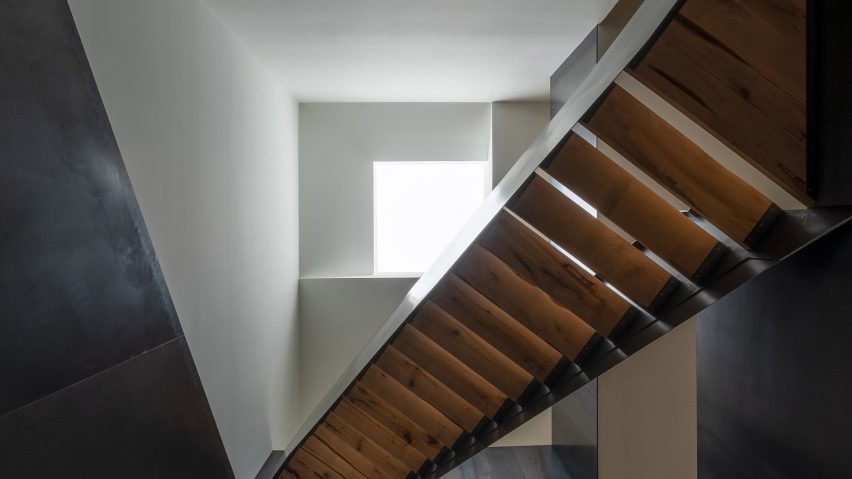An angular steel staircase crosses through this Montreal residence by Naturehumaine, which was inspired by the fantastical paintings of Dutch artist MC Escher.
The Escher House, located in the Rosemont-La-Petite-Patrie neighbourhood, used to be a duplex. Local studio Naturehumaine converted it into a single-family home.
The project included a complete overhaul of the interiors, new cladding, and the addition of a mezzanine, which contains a sitting room and patio. It now encompasses 2,560 square feet (238 square metres).
A new staircase was the centrepiece of the renovation. It is top-lit from a skylight, and visible from every common space.
"All the spaces in the house are organised around the periphery of the staircase, which becomes the central entity of the project," said Naturehumaine.
Black steel plates form the sides and guardrails of the staircase, contrasting its lighter wooden treads. "Imposing, phantasmagorical, the staircase with its crossing of flights enlivens the space and personalises the entire house," the studio explained.
Naturehumaine said that the angular layout of the staircase was inspired by Maurits Cornelis Escher, a Dutch artist born in 1898 who achieved recognition for his depictions of architecturally impossible spaces.
On the ground floor, the layout was converted to an open-concept kitchen, living and dining room, with large openings that expand the living space out onto a terrace in the summer months.
All three bedrooms are located on the first floor. At the front are the two children's bedrooms, separated by a door that used to be the entrance to the upstairs apartment.
The wide landing that separates these smaller bedrooms from the primary bedroom accommodates a desk nook. This overlooks the kitchen below.
The primary bedroom is at the end of the hallway and features a gently curved wall that faces onto the backyard. Irregular punched windows and white-painted wood siding help this volume stand out when seen from the exterior.
The topmost level of the home acts as a secondary sitting area. It was added to the building during the renovation, and its exterior is made of fibre-cement panels left exposed.
The rear facade of the house is clad in charred wood, punctuated by vertical pine slats and raw-fibre cement panels.
Naturehumaine kept to a mostly neutral palette on the interiors, with exposed wooden floors and simple white walls. On the ground level, shades of green were used to mark the entrance of the home.
Other projects by the Montreal-based firm include the renovation of an apartment from a similar time period, into which the team inserted mint green cabinets and curved walls, and a extension to a townhouse that includes a new plywood staircase with a hidden play nook for the children.
The photography is by Ronan Mézière.

